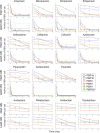Penicillin-Binding Protein 5/6 Acting as a Decoy Target in Pseudomonas aeruginosa Identified by Whole-Cell Receptor Binding and Quantitative Systems Pharmacology
- PMID: 37199612
- PMCID: PMC10269149
- DOI: 10.1128/aac.01603-22
Penicillin-Binding Protein 5/6 Acting as a Decoy Target in Pseudomonas aeruginosa Identified by Whole-Cell Receptor Binding and Quantitative Systems Pharmacology
Abstract
The β-lactam antibiotics have been successfully used for decades to combat susceptible Pseudomonas aeruginosa, which has a notoriously difficult to penetrate outer membrane (OM). However, there is a dearth of data on target site penetration and covalent binding of penicillin-binding proteins (PBP) for β-lactams and β-lactamase inhibitors in intact bacteria. We aimed to determine the time course of PBP binding in intact and lysed cells and estimate the target site penetration and PBP access for 15 compounds in P. aeruginosa PAO1. All β-lactams (at 2 × MIC) considerably bound PBPs 1 to 4 in lysed bacteria. However, PBP binding in intact bacteria was substantially attenuated for slow but not for rapid penetrating β-lactams. Imipenem yielded 1.5 ± 0.11 log10 killing at 1h compared to <0.5 log10 killing for all other drugs. Relative to imipenem, the rate of net influx and PBP access was ~ 2-fold slower for doripenem and meropenem, 7.6-fold for avibactam, 14-fold for ceftazidime, 45-fold for cefepime, 50-fold for sulbactam, 72-fold for ertapenem, ~ 249-fold for piperacillin and aztreonam, 358-fold for tazobactam, ~547-fold for carbenicillin and ticarcillin, and 1,019-fold for cefoxitin. At 2 × MIC, the extent of PBP5/6 binding was highly correlated (r2 = 0.96) with the rate of net influx and PBP access, suggesting that PBP5/6 acted as a decoy target that should be avoided by slowly penetrating, future β-lactams. This first comprehensive assessment of the time course of PBP binding in intact and lysed P. aeruginosa explained why only imipenem killed rapidly. The developed novel covalent binding assay in intact bacteria accounts for all expressed resistance mechanisms.
Keywords: Penicillin binding proteins (PBP); bacterial permeability; beta-lactams/beta-lactamase inhibitors; intact cells; outer membrane penetration; quantitative and systems pharmacology (QSP).
Conflict of interest statement
The authors declare no conflict of interest.
Figures




Similar articles
-
PBP Target Profiling by β-Lactam and β-Lactamase Inhibitors in Intact Pseudomonas aeruginosa: Effects of the Intrinsic and Acquired Resistance Determinants on the Periplasmic Drug Availability.Microbiol Spectr. 2023 Feb 14;11(1):e0303822. doi: 10.1128/spectrum.03038-22. Epub 2022 Dec 8. Microbiol Spectr. 2023. PMID: 36475840 Free PMC article.
-
Role of Pseudomonas aeruginosa low-molecular-mass penicillin-binding proteins in AmpC expression, β-lactam resistance, and peptidoglycan structure.Antimicrob Agents Chemother. 2015 Jul;59(7):3925-34. doi: 10.1128/AAC.05150-14. Epub 2015 Apr 20. Antimicrob Agents Chemother. 2015. PMID: 25896695 Free PMC article.
-
Penicillin-Binding Protein Occupancy Dataset for 18 β-Lactams and 4 β-Lactamase Inhibitors in Neisseria gonorrhoeae.Microbiol Spectr. 2023 Jun 15;11(3):e0069223. doi: 10.1128/spectrum.00692-23. Epub 2023 Apr 24. Microbiol Spectr. 2023. PMID: 37093051 Free PMC article.
-
Sulopenem: An Intravenous and Oral Penem for the Treatment of Urinary Tract Infections Due to Multidrug-Resistant Bacteria.Drugs. 2022 Apr;82(5):533-557. doi: 10.1007/s40265-022-01688-1. Epub 2022 Mar 16. Drugs. 2022. PMID: 35294769 Review.
-
Comparative review of the carbapenems.Drugs. 2007;67(7):1027-52. doi: 10.2165/00003495-200767070-00006. Drugs. 2007. PMID: 17488146 Review.
Cited by
-
Carbapenem-resistant Acinetobacter baumannii raises global alarm for new antibiotic regimens.iScience. 2024 Nov 12;27(12):111367. doi: 10.1016/j.isci.2024.111367. eCollection 2024 Dec 20. iScience. 2024. PMID: 39650735 Free PMC article. Review.
-
Multidrug resistance in Pseudomonas aeruginosa: genetic control mechanisms and therapeutic advances.Mol Biomed. 2024 Nov 27;5(1):62. doi: 10.1186/s43556-024-00221-y. Mol Biomed. 2024. PMID: 39592545 Free PMC article. Review.
-
Specific variants in ftsI reduce carbapenem susceptibility in Pseudomonas aeruginosa.Microbiol Spectr. 2025 Aug 5;13(8):e0102725. doi: 10.1128/spectrum.01027-25. Epub 2025 Jul 7. Microbiol Spectr. 2025. PMID: 40621918 Free PMC article.
-
Metabolic engineering approaches for the biosynthesis of antibiotics.Microb Cell Fact. 2025 Jan 31;24(1):35. doi: 10.1186/s12934-024-02628-2. Microb Cell Fact. 2025. PMID: 39891166 Free PMC article. Review.
-
Differential contribution of PBP occupancy and efflux on the effectiveness of β-lactams at their target site in clinical isolates of Neisseria gonorrhoeae.PLoS Pathog. 2024 Dec 31;20(12):e1012783. doi: 10.1371/journal.ppat.1012783. eCollection 2024 Dec. PLoS Pathog. 2024. PMID: 39739989 Free PMC article.
References
-
- Sunenshine RH, Wright M-O, Maragakis LL, Harris AD, Song X, Hebden J, Cosgrove SE, Anderson A, Carnell J, Jernigan DB, Kleinbaum DG, Perl TM, Standiford HC, Srinivasan A. 2007. Multidrug-resistant Acinetobacter infection mortality rate and length of hospitalization. Emerg Infect Dis 13:97–103. doi:10.3201/eid1301.060716. - DOI - PMC - PubMed
Publication types
MeSH terms
Substances
Grants and funding
LinkOut - more resources
Full Text Sources
Medical
Research Materials
Miscellaneous

